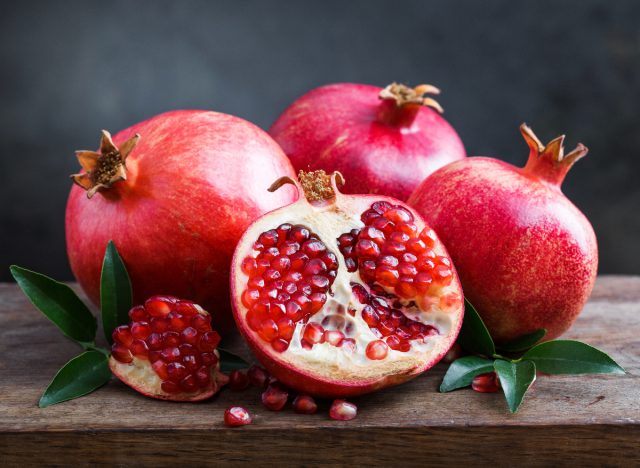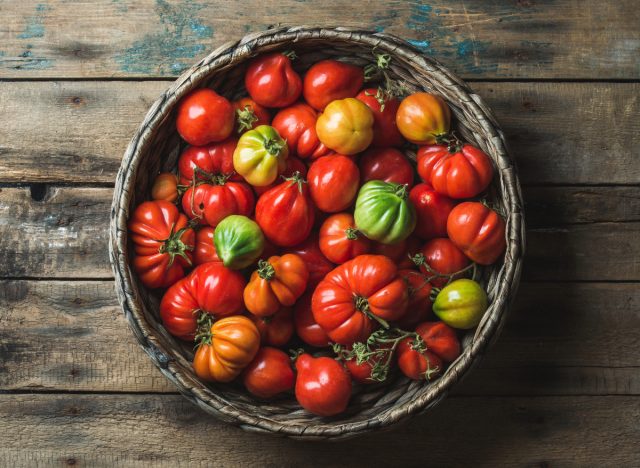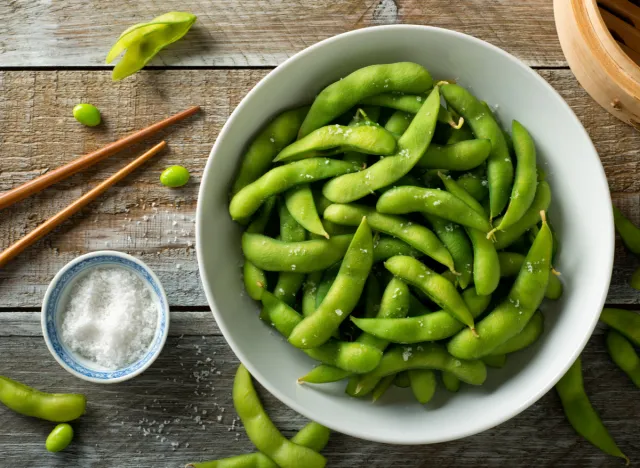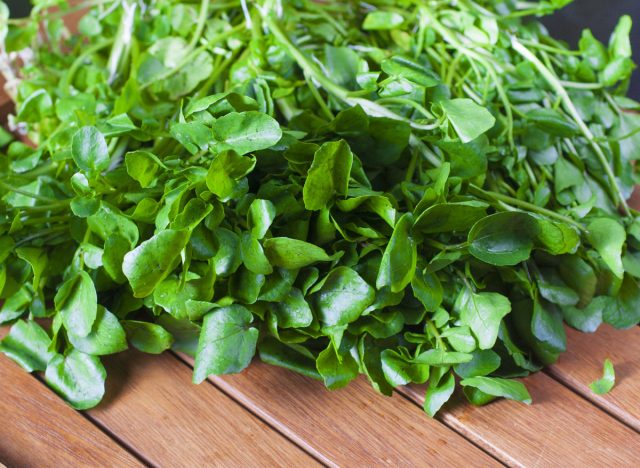25 Foods You Can (Practically) Eat As Much As You Want Without Gaining Weight

At times, losing weight can feel like a never-ending journey. From counting calories to being mindful of portion sizes to finding healthy recipes online you won't tire of, the struggle can be all too real. But what if we told you that there are some foods that you can (practically) eat as much as you want without gaining weight? You heard that right! Whipping up meals and food shopping for weight loss can be both enjoyable and satisfying so long as you have the right tips, tricks, and expertise at your fingertips—and we have you covered.
From fruit like pumpkin and raspberries to crave-worthy snacks like popcorn and brown rice cakes, the foods below are filling, low in calories, and won't derail your weight-loss efforts. (Fruit, for instance, is an excellent choice as it offers carbs from naturally occurring sugars and volume, so you can eat a lot of it. In addition, foods that contain complex carbs support more stable energy and boost satiety, making you feel fuller for a longer period of time.)
Continue reading to learn more, and get ready to update your shopping list.
Watermelon

Who doesn't love enjoying freshly sliced watermelon on a hot summer's day? The next time you head to the store, consider picking one up. A cup of diced watermelon will only cost you around 46 calories, and it's chock-full of water, which will fill you up.
"[This fruit also provides] great nutrition from potassium and antioxidants like vitamin C," explains Annette Snyder, MS, RD, CSOWM, LD from Top Nutrition Coaching. "Consider watermelon a great option post-exercise— they are easy on the stomach as they are relatively low in fiber, but they hydrate and provide the electrolyte potassium, which can be lost in sweat."
Apples

Apples are another fruit you should always have on deck. A large apple has around 148 calories and five grams of fiber.
"The soluble fiber in the flesh of apples is what slows down the rate at which food leaves the stomach, which would then keep you satisfied longer after eating," Snyder tells us. "They take a lot of work to eat with all the chewing, which can slow you down and help you realize when you're getting full. Apples also contain polyphenols thought to prevent fat buildup in the abdomen (the less-healthy kind)."
Popcorn

When snack time rolls around, consider preparing homemade popcorn to give your body nutritious whole grains. One cup of air-popped popcorn has 31 calories, one gram of protein, and one gram of fiber.
However, Jessica G. Anderson, MS, RD, CSSD, LD, ACSM EP-C, a board-certified specialist in sports dietetics from Top Nutrition Coaching, stresses to "be mindful of the flavor add-ins you choose, as the popular use of butter, oils, cheese, and caramel/sugar can quickly make it a high-calorie food."
If you're preparing popcorn at home, Anderson recommends using avocado or olive oil cooking spray. Choose lighter toppings like pickles, herbs, spices, balsamic glaze, or jalapenos to jazz things up. And if you're grocery shopping, Anderson's go-to pick is 365 Whole Foods Market Organic No Oil or Salt Added Microwave Popcorn.
Bananas (Slightly Green)

A slightly green banana, aka one that's not as ripe, provides a ton of resistant starch and pectin, which promote satiety.
"As bananas ripen, the starches are broken down into more simple sugars: a ripe banana contains only 1% resistant starch," says Snyder. "We can't digest resistant starches in the small intestine, and they reach the large intestine intact. This provides food for our good gut bacteria."
Raspberries

One cup of raspberries costs only 78 calories, making them the ideal snack or topping for a cup of Greek yogurt or bowl of hearty oats. Plus, in that one-cup serving, you're also getting 10 grams of fiber and two grams of protein.
"One cup [provides] ample amounts of vitamin C, manganese, and vitamin K," Snyder adds. "The rich amount of fiber is what will ultimately satisfy your hunger and support a healthy microflora in the gut; your gut microbes play a role in managing weight, too."
Puffed Brown Rice Cakes

"Plain brown rice cakes are a low-calorie food that can easily be enjoyed in place of bread or crackers or alone as a snack," says Anderson. "Brown rice cakes enhance satiety (feeling of fullness and satisfaction at meals and snacks) due to their fiber content and airiness."
Be careful when choosing flavor add-ins, especially those that contain salt, as rice cakes can easily become a higher-calorie choice. Anderson recommends Lundberg Family Farms Thin Stackers Brown Rice Lightly Salted Grain Cakes.
Pomegranate

From its seeds to its juice, pomegranates are a truly beneficial food to incorporate into any healthy diet. One cup of pomegranate seeds has only about 120 calories and provides two grams of protein and six grams of fiber. (Plus, research found that drinking 120 mL of pomegranate juice every day for a month substantially lowered fat mass in adults.)
"It takes a while to chew and eat the seeds, slowing you down in the process," Snyder says. "[Pomegranates are] also rich in antioxidants that some scientists suggest may help manage weight, possibly by supporting gut microbes that help fight unintended weight gain."
Tomatoes

Did you know that tomatoes are fruits? One medium-sized red tomato has 22 calories, one gram of protein, and almost two grams of fiber. Although the fiber and protein content is small, tomatoes have little to no fat and are chock-full of potassium, vitamin K, vitamin C, and folate, Snyder explains. "[In addition, they're] made up of 95% water so you get that satisfying volume."
Oats

Let's be honest: Nothing beats a comforting, old-fashioned bowl of oats. One cup of cooked oatmeal has around 134 calories, five grams of protein, and five grams of fiber, and it is a stellar source of zinc, magnesium, phosphorous, and thiamine.
"Cooked oats expand in volume and promote feelings of fullness," explains Anderson. "Choosing plain oats and 'jazzing' them up with your own add-ins is the best way to help keep this a low-calorie food. Consider preparing your plain oats with fresh berries, spices, and unsweet plant milks (e.g., unsweet almond or rice milk)."
Pumpkin

Pumpkin isn't just the main ingredient of your favorite fall treats and meals! This fruit is another low-calorie option that's an excellent addition to your diet any time of the year.
One cup of canned pumpkin without salt has 83 calories, three grams of protein, and seven grams of fiber. "[It also provides] 200% of your daily needs for vitamin A, and ample amounts of vitamin K, copper, vitamin E, iron, magnesium, B vitamins, and vitamin C," Snyder points out.
Chickpeas

Chickpeas, also known as garbanzo beans, are legumes. Research shows that making legumes a regular part of your diet can help you avoid obesity; they also offer a substantial amount of dietary fiber. One cup of drained and rinsed chickpeas, for instance, has 210 calories, 11 grams of protein, and 10 grams of fiber.
"Chickpeas are naturally rich in fiber, protein, B vitamins, iron, phosphorous, and unsaturated fats," says Anderson. "Be sure to choose unsalted/low-sodium canned chickpeas and rinse under cold water to omit any excess salt. Enjoying them as a delicious snack can help curb hunger and promote more stabilized energy."
Some of Anderson's top dietitian picks include Great Value Chick Peas Garbanzos (dried), Kuner's No Salt Added Garbanzo Beans (canned), and Biena Chickpea Snacks (roasted).
Grapefruit

One full pink grapefruit has 74 calories and three grams of fiber. This tasty citrus bite is an excellent addition to a nutritious breakfast. Snyder also informs us that you'll get half a day's worth of vitamin C.
In addition, a study published in the Journal of Medicinal Food discovered that consuming just half of a fresh grapefruit before mealtime was linked to substantial weight loss.
Broccoli Rabe

"Non-starchy vegetables are my first go-to when looking to fill my belly with very little calories," explains Kelli Davenport, MS, RD, from Top Nutrition Coaching. "These veggies are loaded with powerful nutrients, fiber, and water that promote good health."
Broccoli rabe is one of Davenport's top recommendations, as one cup chopped is a mere nine calories; 100 grams worth of broccoli rabe has 22 calories, three grams of protein, and three grams of fiber.
Spaghetti Squash

Spaghetti is a much healthier alternative to traditional noodles when you're whipping up your go-to pasta dishes. "Spaghetti squash is rich in carotenoids (vitamin A), vitamin C, B6, fiber, magnesium, and potassium," Anderson tells us. One cup of cooked spaghetti squash has 76 calories and two grams of fiber.
Parsnips

"Parsnips are a root vegetable closely related to carrots and parsley," explains Anderson. "[They] are rich in fiber, calcium, potassium, manganese, magnesium, phosphorous, zinc, iron, B-vitamins, vitamin C, vitamin E, and vitamin K."
One cup of sliced parsnips is around 100 calories and provides two grams of protein and seven grams of fiber. Add them to a freshly tossed salad for an extra healthy, flavorful bite.
Passion Fruit

Passionfruit is another healthy kitchen staple you can (practically) eat as much as you want without gaining weight. One fruit has 18 calories and two grams of fiber. "It also contains a good amount of fiber and nutrients like vitamin C, vitamin A, iron, and potassium," shares Snyder.
Spinach

If you're looking to add more leafy greens to your meals, spinach is one of the best. It's one of those versatile ingredients you can work into a variety of recipes such as omelets, quiches, smoothies, and pasta dishes.
One bunch of spinach has 78 calories, 10 grams of protein, and almost eight grams of fiber. "Fiber takes a lot of energy just to break down so that we can absorb the nutrients in the food, so eating high fiber foods actually helps you burn more calories just through digestion.
Zucchini Squash

Zucchini squash can be an incredibly tasty addition to your favorite sweet and savory dishes. You can also enjoy it on its own with some herbs and spices. "Try oven roasting, air frying, or explore various zucchini chip products, [like Crispy Bites Zucchini Chips or McCabe Organic Sun-Dried Zucchini,]" Anderson suggests.
One large baby zucchini squash has only four calories. Even though it doesn't offer much protein or fiber (less than one gram of each in this size serving), it's chock-full of beneficial nutrients like phosphorous and potassium. You can easily spiralize it into zucchini noodles as a healthy switch-up to classic noodles.
Acorn Squash

Acorn squash is another tasty delight you can seamlessly turn into "noodles" and swap into meals instead of pasta. Add it to soups or roast it for a scrumptiously sweet snack.
"Acorn squash is rich in vitamin B6, vitamin C, and beta carotene, promoting eye and heart health," says Anderson. An entire acorn squash has just 172 calories and provides three grams of protein and six grams of fiber.
Fava Beans (Broad Beans)

"Fava beans are rich in protein, manganese, folate, iron, and fiber," Anderson points out. One cup of fava beans has 182 calories while providing a whopping 14 grams of protein and almost 10 grams of fiber.
"Roasted and flavored with a variety of herbs and spices, fava beans make a delicious snack," Anderson adds. She also recommends checking out The Good Bean Crispy Favas, Sea Salt on your next grocery run.
Edamame

"Edamame is an excellent source of protein, fiber, and potassium," says Anderson. "Edamame enjoyed from within the pod helps to slow down food intake, allowing hunger-satisfactory cuing to be enhanced." Rather than salt, Anderson suggests seasoning your edamame with spices and herbs for a flavor-packed bite.
Bok Choy

Another way to step up your leafy greens game? Consider bok choy, which is low in the calorie department but packs in the nutrients. In addition, research shows that consuming this veggie could decrease fat accumulation.
One head of bok choy has about 109 calories and provides an impressive 13 grams of protein and eight grams of fiber. "Fiber is great for helping with satiety (feeling of fullness) and for gut regularity," says Davenport. "Fiber also provides food for the healthy bacteria in our gut, making them a great source of pre-biotics."
Jalapeño

Davenport suggests spicing up your meals—quite literally—with jalapeños. One cup of sliced jalapeño peppers provides three grams of fiber and one gram of protein while only costing 26 calories. Additionally, research shows that capsaicin, a compound found in hot peppers, can help rev up your metabolism and speed up weight loss.
Watercress

If you haven't been adding watercress to your freshly tossed salads, you've seriously been missing out! And there's no time better than the present to fix that. One cup of chopped watercress has only four calories and provides a whole host of nutrients, such as 20 milligrams of phosphorous, 112 milligrams of potassium, and 41 milligrams of calcium.
Celery

Last but not least, celery most certainly deserves a spot on this list. One cup of chopped celery has just 14 calories and almost two grams of fiber. Plus, most of it is water, which will help fill you up for not many calories!
Celery is just one of those seamless snacks to always keep in the fridge for hot summer days. This refreshing, crunchy veggie can be enjoyed with creamy nut butter, hummus, or a homemade ranch dip when the craving hits.
- Source: The Dietary Fiber Pectin: Health Benefits and Potential for the Treatment of Allergies by Modulation of Gut Microbiota
- Source: Effect of Pomegranate Extract Consumption on Satiety Parameters in Healthy Volunteers: A Preliminary Randomized Study
- Source: The Potential Effects of Dietary Antioxidants in Obesity: A Comprehensive Review of the Literature
- Source: Dietary fiber and satiety: the effects of oats on satiety
- Source: The effects of grapefruit on weight and insulin resistance: relationship to the metabolic syndrome
- Source: Dietary capsaicin and its anti-obesity potency: from mechanism to clinical implications









